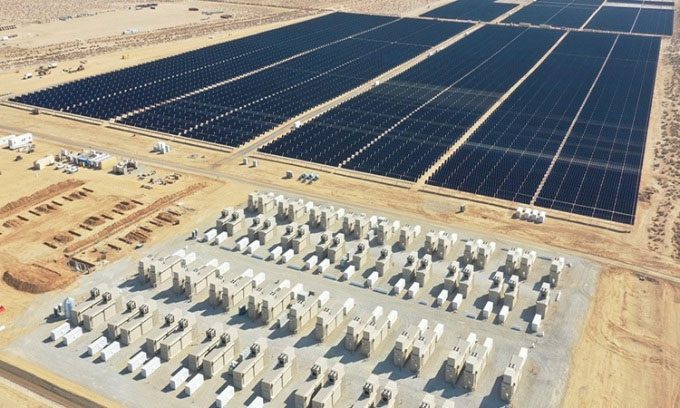In the Mojave Desert, California, one of the sunniest places on Earth, the world’s largest solar power and battery storage project has begun full operations.
Edwards & Sanborn Solar and Energy Storage Facility comprises nearly two million solar panels. This expansive solar farm boasts a capacity of 875 megawatts, the highest of any facility in the United States. It also has the capability to store 3,287 megawatt-hours of electricity in over 120,000 battery units. Such storage capacity allows the facility to maintain power supply even during peak demand periods or when sunlight is not available, IFL Science reported on February 16.

Aerial view of the Edwards & Sanborn Solar and Energy Storage Facility. (Photo: Mortenson).
This solar power plant covers a total area of 1,886 hectares, approximately one-third the size of Manhattan in New York. To connect the entire system, engineers had to install over 724 kilometers of power lines. The Landsat-9 satellite captured images of the farm on January 12, 2024, just before its inauguration. Mortenson, the construction and engineering services contractor, began building the project in early 2021. The facility has been operational since February 2023 and fully operational since January 2024.
In terms of size and capacity, the world’s largest solar farm is the Golmud Solar Park in China, with an installed capacity of 2.8 gigawatts, followed by the Bhadla Solar Park in India (2.7 gigawatts). The Edwards & Sanborn Solar and Energy Storage Facility differs from these locations in that it is the largest solar power and battery storage project in the world, according to Mortenson, surpassing the Vistra facility at Moss Landing, California.
Solar energy is set to become a crucial renewable energy source that helps the world reduce fossil fuel use, which currently contributes the most to climate change. However, solar farm infrastructure faces its own challenges. Solar storage typically relies on lithium-ion batteries made from rare materials such as lithium and cobalt. Mining these metals poses significant environmental risks, threatening local communities and ecosystems.
Building solar farms also requires vast amounts of land. The Mojave Desert has seen a surge of solar farms in recent years, including the 60,700-hectare East Riverside Solar Area. The development of infrastructure in the Mojave has a significant impact on the natural habitat of many species, such as the flat-tailed horned lizard and desert tortoise.


















































